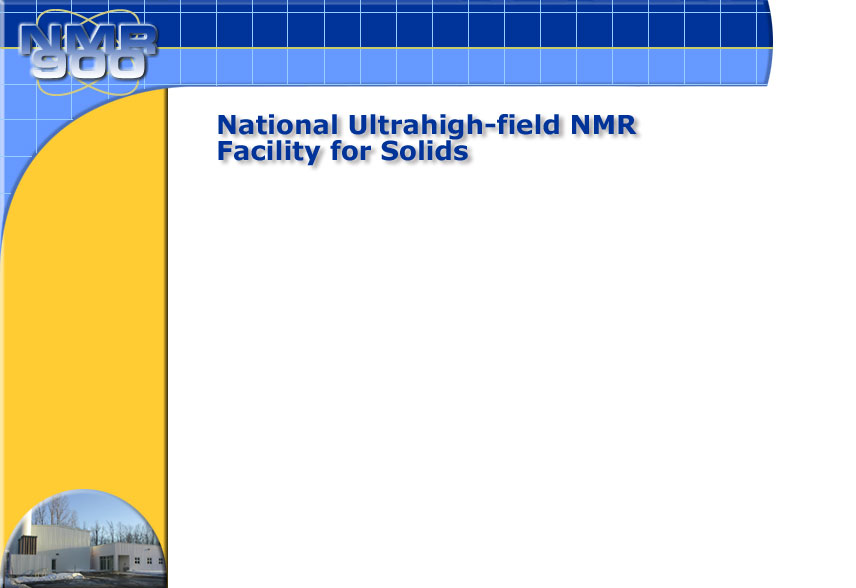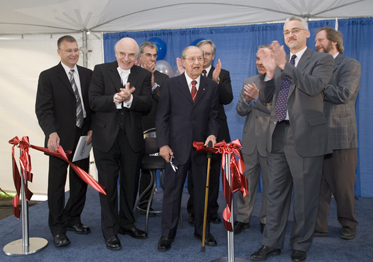
A
Magnet for the Nation
NRC, uOttawa
home to Canada’s most powerful magnet
June 1, 2006, Ottawa, ON — Today, the Government of Canada in partnership
with the University of Ottawa and the provinces of Quebec and Ontario officially
opened the $15 million NRC W.G. Schneider Building. Named after nuclear magnetic
resonance (NMR) pioneer and former NRC President, Dr. Schneider, this unique
building accommodates two NMR facilities – home to a critical mass of
5 spectrometers.

Left to right: Henry Stronks (President, Bruker Biospin), Royal Galipeau (MP-Ottawa-Orleans), Pierre Coulombe (President, NRC), W.G. Schneider, Gilles Patry (President, University of Ottawa), Eliott Phillipson (President, Canadian Foundation for Innovation), Danial Wayner (Director General, Steacie Institute for Molecular Sciences), Christian Detellier, Dean of Science, University of Ottawa)
“These cutting edge facilities contribute to the Government of Canada’s commitment to improve Canada's innovation performance and increase its ability to compete in the global marketplace,” said Royal Galipeau, Member of Parliament for Ottawa-Orléans, who attended the event on behalf of the Honourable Maxime Bernier, Minister of Industry and Minister responsible for the NRC. “We feel it is important to foster scientific research in order to increase Canada’s technological and industrial capacity“.
The main attraction for Canadian scientists and industry is the multimillion dollar 900 MHz (21.1 Tesla) spectrometer, Canada’s most powerful magnet. It will provide scientists with a new tool in their efforts to develop new battery composites, nano-materials for electronics, plastic polymers for vehicles, glasses for more sensitive sensors and faster computer processors, new materials for hydrogen storage, as well as health enhancing antibiotics.
“This new facility is a prime example of what can be achieved through collaboration.” said NRC President Dr. Pierre Coulombe. “NRC believes that strategic partnerships like this one are key to building Canada’s knowledge based economy.”
Since 1959, magnetic resonance has evolved and led to the development of medical imaging and diagnosing equipment – Magnetic Resonance Imaging commonly known as the MRI. The partners recognize the importance of researching quantum physics and chemistry through spectroscopic measures in order to build upon the strengths of innovative materials. This characterization of new materials and elements will improve our understanding and creation of aeronautical composites for the aerospace industry as well as more selective antimicrobial therapies for more economical air travel and healthier lives.
“The National Ultra-high Field NMR Facility for Solids is the first of its kind in the world and will promote international interest and collaboration, increasing Canada’s scientific prestige on the global stage,” says University of Ottawa President Gilles Patry. “Our institution is committed to promoting the exciting interdisciplinary work of our researchers through partnerships like this one and we look forward to the benefits this facility will offer the uOttawa community.”
This uniquely nationwide networked centre was made possible thanks to the support of its public and private partners including Canada Foundation for Innovation (CFI) funding, a co-development agreement with Bruker Biospin and the collaborative staffing expertise and management from the University of Ottawa and NRC.
About
NRC:
Recognized globally for research and innovation, Canada's National Research
Council (NRC) is a leader in the development of an innovative, knowledge-based
economy for Canada through science and technology.
About
University of Ottawa:
The University of Ottawa is one of Canada’s principal comprehensive,
research-intensive, postsecondary institutions. Its campus community totals
more than 35,000 full-time students, faculty and staff living, working and
studying in both of Canada’s official languages in a thoroughly cosmopolitan
milieu. We’re proud to call ourselves “Canada’s university.”
About
CFI:
The Canada Foundation for Innovation (CFI) is an independent corporation created
by the Government of Canada to fund research infrastructure. The CFI’s
mandate is to strengthen the capacity of Canadian universities, colleges,
research hospitals, and non-profit research institutions to carry out world-class
research and technology development that benefits Canadians.
About
Bruker BioSpin:
Bruker BioSpin, a division of Bruker, is dedicated to designing, manufacturing
and distributing life science tools based on magnetic resonance. Bruker, a
world leader in the manufacture and development of scientific instrumentation
was incorporated in Canada in October, 1970. The company grew dramatically
in the late 1970’s and early 1980’s and now employs over 25 people
in Canada including scientists, service engineers and administrative support
teams who work closely with colleagues in the U.S., Germany and Switzerland.
- 30 -
For further information on the two facilities located at the Schneider building, please consult: http://nmr-rmn.nrc-cnrc.gc.ca/facilities/mrfacility_e.html and http://www.nmr900.ca or contact:
Helene
Letourneau
Communications Officer
The Steacie Institute for Molecular Sciences
National Research Council Canada
Tel: (613) 991-5419
helene.letourneau@nrc-cnrc.gc.ca
Sophie
Nadeau
Media Relations Officer
University of Ottawa
Tel: (613) 562-5800 ext 3137
snadeau@uOttawa.ca